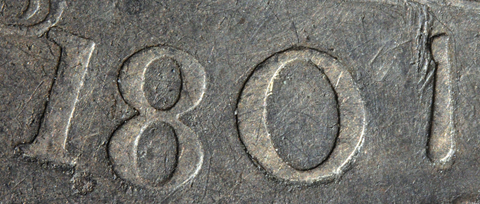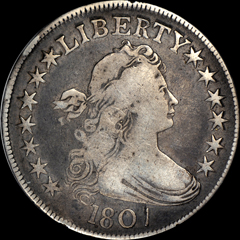Counterfeit Detection: Variety Attribution – 1801 Half Dollar
Posted on 8/16/2011
Early silver dollars are frequently faked and the quality of these counterfeits varies from extremely crude to superb. The 1804 dollar is, of course, the most commonly faked date, but every year has been observed. These are primarily made in Asia for sale to unsuspecting tourists. While counterfeit dollars are plentiful, fake half dollars are seldom seen. We did find one, however, in a submission that included several genuine half and silver dollars.
This spurious half dollar is actually an altered date: an 1807 half was made to look like an 1801. This is a very crude alteration but it’s worth looking at because it is pretty unusual and fooled at least one collector. The final digit, the 7, was altered by scratching away the top crossbar so that it resembles a 1. The 1 therefore slants prominently to the right. There are also deep scratches to the left of the upright, a clear sign that some kind of tool was used to scratch away part of the 7.

With early United States issues it is usually possible to look up the die variety in one of the many specialized references that have been written. Die varieties of early half dollars, for example, have been cataloged by Al Overton. Identifying a coin as one of these known varieties can help confirm authenticity. Many fakes were struck from dies made by the counterfeiter and therefore do not match any known varieties. If your coin is not listed in one of these variety references, you should probably take a second look. Although the altered date was fairly obvious on this half dollar, we decided to look it up in Overton’s Early Half Dollar Die Varieties, 1794-1836. Confirming our original thoughts, this half dollar matched 1807 Overton-110.
Some Important Variety References for Early United States Coins:
Stay Informed
Want news like this delivered to your inbox once a month? Subscribe to the free NGC eNewsletter today!


